can anyone identify this tube amp , i want to restore it and i need a schematic , i think it was used in some type of tone cabinet , there is no markings on it other then 2222 printed on the front of it . power tubes are supposed to be 6l6gc , other tubes are 6c8 , 6c5 , 6h6 , 5u4 rectifier ,
the power transformer is branded STANDARD RADIO PRODUCTS OF KITCHENER ONTARIO CANADA .
Please let me know if you know what it is.
the power transformer is branded STANDARD RADIO PRODUCTS OF KITCHENER ONTARIO CANADA .
Please let me know if you know what it is.
Attachments
-
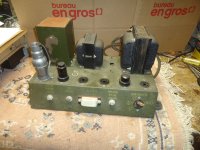 TONE CABINET TUBE AMPLIFIER 001.JPG564.1 KB · Views: 205
TONE CABINET TUBE AMPLIFIER 001.JPG564.1 KB · Views: 205 -
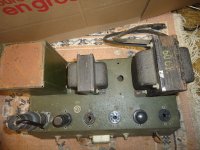 TONE CABINET TUBE AMPLIFIER 003.JPG582 KB · Views: 203
TONE CABINET TUBE AMPLIFIER 003.JPG582 KB · Views: 203 -
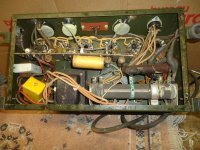 TONE CABINET TUBE AMPLIFIER 009.JPG688.7 KB · Views: 194
TONE CABINET TUBE AMPLIFIER 009.JPG688.7 KB · Views: 194 -
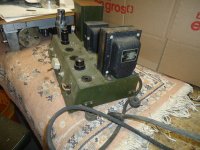 TONE CABINET TUBE AMPLIFIER 005.JPG635.6 KB · Views: 188
TONE CABINET TUBE AMPLIFIER 005.JPG635.6 KB · Views: 188 -
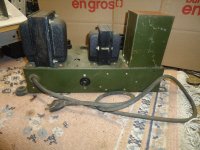 TONE CABINET TUBE AMPLIFIER 008.JPG588.2 KB · Views: 186
TONE CABINET TUBE AMPLIFIER 008.JPG588.2 KB · Views: 186 -
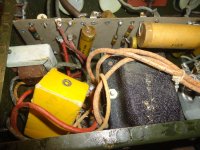 TONE CABINET TUBE AMPLIFIER 012.JPG629.7 KB · Views: 181
TONE CABINET TUBE AMPLIFIER 012.JPG629.7 KB · Views: 181 -
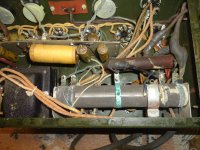 TONE CABINET TUBE AMPLIFIER 011.JPG637.3 KB · Views: 202
TONE CABINET TUBE AMPLIFIER 011.JPG637.3 KB · Views: 202
Last edited by a moderator:
In addition to the paint, many things make you think of something military.
Metal-wrapped tubes
No indicator light
Mounted on silent blocks.
And many other things tell me otherwise
No voltmeter or ammeter
Riveted sockets
Rough screen printing
No protective cover.
In short, I have no idea but I would clearly go more towards a jukebox amp.
Metal-wrapped tubes
No indicator light
Mounted on silent blocks.
And many other things tell me otherwise
No voltmeter or ammeter
Riveted sockets
Rough screen printing
No protective cover.
In short, I have no idea but I would clearly go more towards a jukebox amp.
The biggest audio manufacturer in Kitchener was Electrohome. Possibly from one of their consoles?
It conforms closest to an organ tone generator amplifier. The 'tone cabinets' socket probably being used in lieu of a contact strip for alternate ohm loads, I, 2, and 3 being the number of outboard speakers/cabinets you ran from it. Given that 'tone cabinet' was used primarily or only by the Hammond Organ Co the best contender would be a company called Northern Electric that made Hammond organs and some of their internal components like amplifiers under license in Belleville, Ontario from the late 1940's into the 50's. Northern Electric later became Northern Telecom, then Nortel.
The use of a tube socket for a multi-pin jack socket conforms to 1940's RCA jukebox but the lack of a speaker output contact strip doesn't. That also excludes console audio, which would not use 'tone cabinets' and used contact strips for the speaker outputs even in the 1930's.
Various components on it conform to 1940's - 1950's, the bakelite plug on the power cord, the mono connector type on the left end (used for microphone and turntable inputs at that time but could also be a switch connection), and using tube sockets as a contact strip or jack socket, which is what the socket on the back of the chassis would be, the input if it is an organ, accordion or other complex tone generator amp.
The mounting brackets are 'anti-vibration' and were used for mounting a chassis into something that would be moved/installed and to potentially extend tube life in stationary items.
It is really the 'tone cabinets' choice of words that narrows down what it's probable purpose was, tone/signal generators and their amps served multiple civilian and military purposes in the 1940's. The paint color choice and stenciled text in yellow immediately made me think WW2 Canadian military but late 1940's that was a common way to apply text and they had a lot of that green paint left over from the war, sold as surplus at a discount. The lack of a data plate is odd, but again just points towards that time period.
The use of a tube socket for a multi-pin jack socket conforms to 1940's RCA jukebox but the lack of a speaker output contact strip doesn't. That also excludes console audio, which would not use 'tone cabinets' and used contact strips for the speaker outputs even in the 1930's.
Various components on it conform to 1940's - 1950's, the bakelite plug on the power cord, the mono connector type on the left end (used for microphone and turntable inputs at that time but could also be a switch connection), and using tube sockets as a contact strip or jack socket, which is what the socket on the back of the chassis would be, the input if it is an organ, accordion or other complex tone generator amp.
The mounting brackets are 'anti-vibration' and were used for mounting a chassis into something that would be moved/installed and to potentially extend tube life in stationary items.
It is really the 'tone cabinets' choice of words that narrows down what it's probable purpose was, tone/signal generators and their amps served multiple civilian and military purposes in the 1940's. The paint color choice and stenciled text in yellow immediately made me think WW2 Canadian military but late 1940's that was a common way to apply text and they had a lot of that green paint left over from the war, sold as surplus at a discount. The lack of a data plate is odd, but again just points towards that time period.
This shares the same tube lineup and has some family resemblance, but is not the same.
Sound Craft Amplifier 403 B
Sound Craft Amplifier 403 B
OldHector wins the cookie on this one. Too many similarities and a very limited field of alternatives.
These may have been hearing test amplifiers, medical, laboratory or military. That is one application that would use at least two tone cabinets and might use three for a center. Hammond organ tone cabinet amplifiers were located in the speaker cabinet and wouldn't require the 'tone cabinets' socket.
These may have been hearing test amplifiers, medical, laboratory or military. That is one application that would use at least two tone cabinets and might use three for a center. Hammond organ tone cabinet amplifiers were located in the speaker cabinet and wouldn't require the 'tone cabinets' socket.
Exactly. In addition, Hammond Organ Co. used to make their own amplifiers without sourcing out the manufacturing. All Hammond amplifiers have a type # starting with AO-.
Best regards!
Best regards!
Kay Pirinha, Northern Electric manufactured Hammond Organs in Canada under license from the late 1940's, into the 1950's using some US made internal components and some made by Northern Electric, 'preamplifiers' have been noted so amplifiers wouldn't be a stretch (not this amplifier though). It isn't sourcing out, it is manufacturing under license. The same thing happened with Jensen speakers in Canada in the early 1970's, the speakers being manufactured by Radio Speaker of Canada (RSC). This amp appears to have the preamp included.
The sloped chassis front is more consistent with a user interface as opposed to an internal component, chassis for internal integration usually didn't get painted and the 'tone cabinets' tap does not fit for Hammond. 'Tone cabinet' is a term associated with Hammond because they used that term for their powered speaker cabinets but it wasn't proprietary and they didn't necessarily invent the term. The 'min volume' control also doesn't appear on other organ amps. That could be part of a 'swell'/expression circuit though.
'AO' denotes Hammond Organ Co for their part's lists and was included on all components that have a part number on them, including those made by third parties.
The lack of a manufacturer data plate on the OP's amp points to a few specific things, earlier year of manufacture, embedded in a larger item and/or military. The lettering method also points to military or earlier time period.
The sloped chassis front is more consistent with a user interface as opposed to an internal component, chassis for internal integration usually didn't get painted and the 'tone cabinets' tap does not fit for Hammond. 'Tone cabinet' is a term associated with Hammond because they used that term for their powered speaker cabinets but it wasn't proprietary and they didn't necessarily invent the term. The 'min volume' control also doesn't appear on other organ amps. That could be part of a 'swell'/expression circuit though.
'AO' denotes Hammond Organ Co for their part's lists and was included on all components that have a part number on them, including those made by third parties.
The lack of a manufacturer data plate on the OP's amp points to a few specific things, earlier year of manufacture, embedded in a larger item and/or military. The lettering method also points to military or earlier time period.
Last edited:
Another Sound Craft Amplifier, made in 1946 for electric lap steel guitar, an instrument invented in the early - mid 1930's by Paul Tutmarc.
Verifies that N.H. Speight Laboratories of Toronto is the manufacturer.
This link includes some chassis photos, the schematic and the cabinet...
https://www.guitarscanada.com/threads/found-this-old-sound-craft-amp-yesterday.70880/
Verifies that N.H. Speight Laboratories of Toronto is the manufacturer.
This link includes some chassis photos, the schematic and the cabinet...
https://www.guitarscanada.com/threads/found-this-old-sound-craft-amp-yesterday.70880/
Last edited:
- Home
- Amplifiers
- Tubes / Valves
- Need help to identify an amplifier